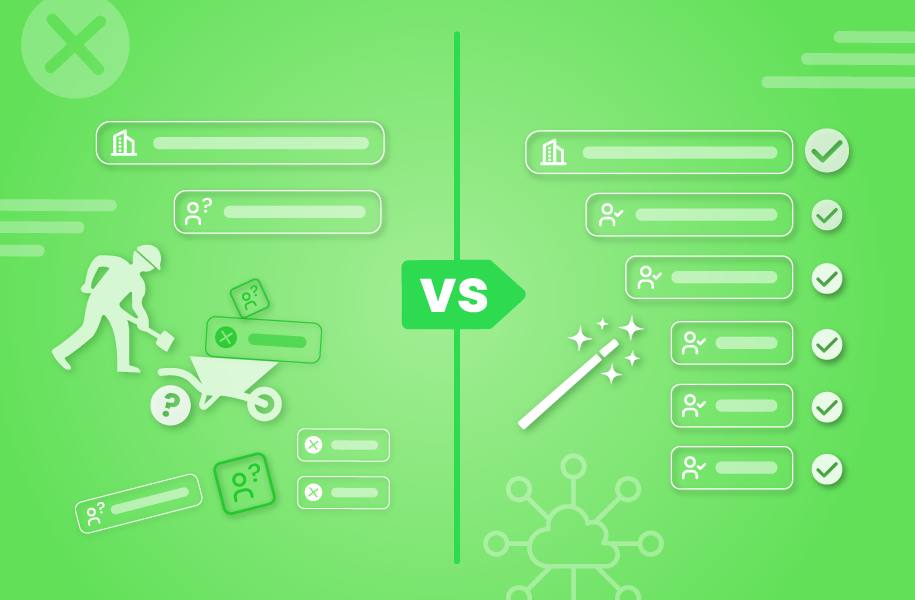Introduction: The current challenges of B2B selling
It’s no secret. The B2B buying journey is complex and it’s getting harder for sales teams to close deals.
Gartner estimates that the average size of a B2B buyer committee is six to 10 decision-makers.
However, research from Foundry, which focuses on enterprise technology purchases, puts the average buying committee at 25 stakeholders.
On top of large buyer committees, several challenges make B2B selling difficult:
1. Sales reps will talk to one champion at a company. What they fail to recognize, is there are other stakeholders involved who can help them close the deal.
“There are more people in this buying journey, which adds more complexity. There’s lots more people that can say no to a deal, but there’s only a couple that can say yes. The sales rep has to navigate that org structure to figure out who’s who.”
– David Nelson, CEO of Traction Complete
2. Companies will often use Quip or static org charts to track stakeholders – but this means important notes and account information live outside of Salesforce. Org charts also don’t give enough information to identify or nurture key decision-makers.
3. Sales teams change just as often as buyer committees do, and tracking that knowledge is difficult. What happens to that knowledge when a sales rep leaves the company? And subsequently, how can you ensure a smooth transition to the new rep?
4. When sales leaders manage dozens of sales reps, it becomes difficult to understand the health and potential of open opportunities and provide meaningful coaching and feedback.
You might also like:
- What is a relationship map in Salesforce (and why you need one)
- How to automate the Opportunity Contact Role Field in Salesforce
- 3 Salesforce sales processes stopping you from selling more
So what’s the solution?
Between navigating complex buyer and seller committees, outdated org charts, and dozens of ongoing deals, efficient B2B selling calls for a smarter solution.
In our latest webinar with Foundry, David Nelson, CEO of Traction Complete, and Lenore Lang, SVP and GM of Communications and Media at Salesforce, talk about how relationship mapping helps B2B sales teams turn influencers into buyers.
Here are their answers to some of the biggest challenges plaguing B2B sales teams, as well as how to use a relationship map to close more deals.
But before all that – what’s a relationship map in Salesforce and what does it do?
Q: What is a relationship map in Salesforce?
A relationship map, also known as an influence map, allows users to track organizational structures, the different relationships within them, and the decision influence that a person has in a deal.
Relationship maps can also help by:
- Allowing sales leaders to quickly see buying committee structures across multiple accounts
- Optimizing sales coaching and account planning
- Encouraging reps to add more contacts to an opportunity
- Tracking partner relationships that are also in play during deals
- Improve attribution for marketing
- Making revenue growth more efficient and predictable
Q: What’s the biggest challenge that sales reps are seeing?
“I think the macro has changed the landscape of who the actual buyer is. What we are seeing now, whether it’s mid-market, commercial, enterprise, or strategic, is that CFO’s involvement is critical.”
– Lenore Lang, SVP and GM of Communications and Media, Salesforce
Lenore explains that at Salesforce they traditionally sell to a line of business. This could be revenue or IT leaders.
But with the change and involvement of the CFO in deals, her sales team has had to diversify in a way they map out executives. They also need to ensure they’re effectively displaying value for the products or services they’re offering.
Q: How can you better enable your sales team throughout the year, or in deal reviews?
Sales teams at Salesforce have three assets, in the form of slides, that are always kept up to date.
Vision: This asset describes the sales reps’ vision for the customer and how they’re going to help them get there. This requires research, doing homework to understand the client, and how the sales rep can uniquely help the customer solve that problem.
“It’s a future vision. 12 to 36 months, or even a five-year vision based on the relationship with that customer and how much they know about them. When they get in front of the CFO or C-suite executive, there’s an understanding of what they’re dealing with, how they’re going to respond to the company’s problems, and where they’re going to take them.”
– Lenore Lang
Deal Review: This tried and true review slide includes the basic mechanics of the deal, close plans, and how the sales rep plans to get there. This asset should also include details like what products and services are being offered and how far in the sales cycle the deal is.
“This helps identify red flags along the way, partners that can be involved and understanding the upcoming executive engagements and any challenges that the account team foresees.”
– Lenore Lang
Relationship Map: The third asset is a relationship map that outlines who the stakeholders and champions are, when the last connect was with them, and what kind of steps can be taken to turn blockers into champions.
Lenore’s advice for how to best use a relationship map? Embrace the relationships that haven’t been turned into champions – what matters more is having a plan of action instead.
“What I see the best teams doing when they look at a relationship map is that they view it as a scorecard. And a scorecard, very rarely, is all green. You’re going to have some sort of markup, some sort of relationship you desire that you don’t have today. What I’m looking for is what are the steps you’re going to take to garner that relationship – and most importantly [as a leader], how can I help?
– Lenore Lang
Finally, make sure that the visions and deal review assets are always in motion and always being updated. It’s one thing for a sales rep to create a vision when they start working on a deal — it’s another thing to keep growing through it and working across the organizational structure.
Q: With multiple stakeholders involved in purchases, how do you enable and operationalize sellers to sell more effectively to large buyer groups?
The first step to selling more effectively to large buyer groups is putting the data into Salesforce.
Visibility and access are critical, which is where relationship maps come in. It makes it easy for sales reps to visualize who they’ve engaged with and creates a better way to track org structures, political relationships, and champions and blockers.
David adds that having this information visible in a CRM is a massive help to account managers and customer success teams.
“You want it in the CRM. You want it to be visible on the account and opportunity level. Sales reps live and breathe opportunities. But the higher you get in terms of enterprise sales, the more it becomes about the account. When you hand off that account, [your team] needs access to that important information.”
– David Nelson
The next tactic is to ensure that sales reps are looking for multiple champions. When sales reps stick to one champion and focus all their efforts on them, it can hurt the likelihood that a deal closes.
“The longer you work with an individual champion, the more awkward it becomes to get above them if they become a blocker. Sometimes they’re open to brokering you in; sometimes they don’t even have that luxury where they’re too low on the chain and they can’t get you up. You want to get in as early as possible and navigate that structure.”
– David Nelson
Q: How can a sales team integrate relationship mapping into their workflow and use it daily?
“Sales reps love talking to people – they don’t love entering data. Try to automate as much as you can. You want to be capturing the conversations that they’re having, you want to be adding those records into your CRM instead of having to do it manually.”
– David Nelson
Automation is key to helping sales teams integrate relationship mapping into their daily routine.
The payoff is that during meetings with sales leaders, you spend less time updating and more time strategizing.
When a team runs sales check-ins on opportunities, you need to understand where that opportunity sits. Who are the champions? Who are the blockers that ended up being convinced?
And when relationship maps become a consistent part of check-ins, sales reps are more incentivized to keep them updated.
“A lot of times, what can help is to review [relationship maps] together with your sales team. Nothing puts more pressure on a rep than having to show something blank.”
– David Nelson
Q: When looking at a relationship map, how many people do you expect to see?
“As many squares as can fit on a digital piece of paper. There’s the view that the seller wants to see, then there’s the real view. I want the real view; I don’t want what everyone wants me to see. Oftentimes, more experienced teams that may be seeling to one account, versus one to many, sometimes you get blinders on.”
– Lenore Lang
Lenore stresses that when you’re working a single account, it’s natural to have blinders on – you see what you want to see and hear what you want to hear.
One of the biggest positives of having a sales leader look at a comprehensive relationship map is that they don’t have blinders on. They’re still learning and they can ask questions that a seller may not think. But if they can’t see the full picture, they won’t be able to do that effectively.
Conclusion
Complete Influence makes it easy for your sales reps to visualize who they’ve engaged with and who can influence buying decisions. That way, they know where to focus their attention.
Users can visualize and track notes and next steps in Salesforce – Sales leaders don’t have to dig through scattered sales notes to determine who’s in the buying cycle and where they can help.
Most importantly, this makes revenue growth more efficient and predictable by incorporating everyone on the deal.





